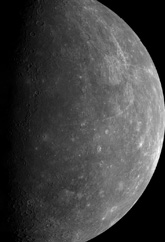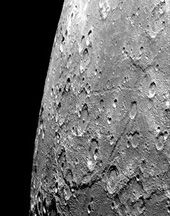
until 1639, however, that another Italian astronomer, Giovanni Zupus discovered that it circled the Sun. Then between 1881 and 1889 Giovanni Schiaparelli made the first map of Mercury's surface features. Much later, in 1968, Surveyor 7 took the first spacecraft picture of Mercury from the Moon and in 1974-75 the Mariner 10 space probe paid Mercury a visit. Over 3 decades later, the MESSENGER space probe paid Mercury a long overdue visit in 2008, and will be orbiting and studying the planet in detail from 2011 ................................................................................ Being the planet closest to the Sun, Mercury (the Messenger of the gods) guards its secrets very carefully. With a mean heliocentric distance of just 0.387 AU (about 57.8 million km) and a orbit time of just under 88 days, it is not very easy to observe from Earth and never appears more than 27° from the Sun (less than the angle made by the hands of a watch at 1 o'clock).
telescopes is that because it never strays far from the Sun, it can only be observed during the day, when scattered sunlight impedes clear views of the planet, or just before sunrise and after sunset, when the light we recieve from it must pass through 10 times as much atmosp- -heric turbulence as when it is directly overhead. Unfortunately this means that even the best ground based telescopes get a worse view of it than humans can get of the moon with the naked eye each night. This has obviously proved an obstacle to finding out much about Mercury, and as such, for a long time we knew very little more about Mercury, one of our closest neighbours, even as we were studying other planets much further away in far greater detail. This state of affairs is rapidly changing however thanks to missions to Mercury such as NASA's MESSENGER space probe which in 2011 became the first space probe to enter into orbit around Mercury. Up to that point , most of our knowledge, and pictures, of Mercury came courtesy of the Mariner 10 spacecraft, which mapped 40% of the planet over 3 fly-bys in the mid 1970s, though it wasn't until 2010 that Messenger was able to map Mercury's previously unseen dark side in its fly-bys. Even the Hubble Space Telescope cannot look directly at Mercury, in case Solar rays damage its sensitive instruments. Mercury is a pretty small planet with a diameter of only 4880 km - about one third the size of the planet Earth. Mercury has a big Iron core which makes up 75% of the whole planet's diameter, and which recent observations carried out in 2007 have shown may in fact be liquid. This core is surrounded by a rocky mantle and crust about 600km thick. Mercury's outer surface is quite cratered and, like the moon, is covered in fine soil. It also has an elliptical orbit which, although not as elliptical as Pluto's, is very marked, as the closest it gets to the Sun (its perihelion) is 46 million km while the furthest it ever gets (its aphelion) is 70 million km.
Mercury is the only solid planet other than Earth known to have a magnetic field, and whilst it is only about 1% the strength of the Earth's magnetic field, it is nonetheless surprisingly strong for such a small planet. This feature is explained by the presence of the large Iron core at the planet's centre. Merury doesn't have an atmosphere because it is so close to the Sun, though its surface is surrounded by a thin layer of particles created in collisions between the Solar Wind and the planet's surface - a quasi-atmosphere known as an exosphere. In size, Mercury is about intermediate between the Earth and its Moon. Mercury has a high mean density of 5.43g/cm3, which is quite similar to those of the Earth (5.5) and Venus (5.2). However whilst the latter two planets are relatively large and and so have enough overlying mass to compress their interiors, this is not the case with Mercury and so its density can only be explained by the presence of a greater proportion of heavy elements. The planet's composition is roughly 70% Iron (with some Nickel) and 30% Silicate material, with the majority of this Iron believed to be housed, as discussed above, in a large possibly liquid core which extends to around 75% of Mercury's radius. Observations carried out in the early 1990s also discovered small quantities of water ice to be present on Mercury, housed in permanently shady areas inside craters around the planet's poles. This water probably arrived there from comet or meteorite collisions. Since Mercury is so much closer to the Sun than we are, in the Mercurian sky the Sun appears three times as big as from here on Earth. If you want to see Mercury from Earth, it's faintly visible flashing for a short while just before sunrise and just after sunset. The biggest basin on Mercury, the Caloris Basin was formed when an asteroid 100 km wide travelling at 512,000 km/hour crashed into Mercury. The impact was so great that it sent an almost instant shockwave throughout the planet, creating the hilly, lineated terrain it has today. | |||||||||||||||||||||||||||
Mercury
Subscribe to:
Posts (Atom)

